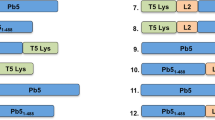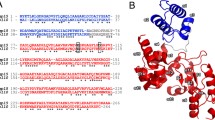Abstract
The widespread use of antibiotics has caused serious drug resistance. Bacteria that were once easily treatable are now extremely difficult to treat. Endolysin can be used as an alternative to antibiotics for the treatment of drug-resistant bacteria. To analyze the antibacterial activity of the endolysin of phage Bp7 (Bp7e), a 489-bp DNA fragment of endolysin Bp7e was PCR-amplified from a phage Bp7 genome and cloned, and then a pET28a-Bp7e prokaryotic expression vector was constructed. Two amino acids were mutated (L99A, M102E) to construct pET28a-Bp7Δe, with pET28a-Bp7e as a template. Phylogenetic analysis suggested that BP7e belongs to a T4-like phage endolysin group. Bp7e and its mutant Bp7Δe were expressed in Escherichia coli BL21(DE3) as soluble proteins. They were purified by affinity chromatography, and then their antibacterial activities were analyzed. The results demonstrated that the recombinant proteins Bp7e and Bp7Δe showed obvious antibacterial activity against Micrococcus lysodeikticus but no activity against Staphylococcus aureus. In the presence of malic acid, Bp7e and Bp7Δe exhibited an effect on most E. coli strains which could be lysed by phage Bp7, but no effect on Salmonella paratyphi or Pseudomonas aeruginosa. Moreover, Bp7Δe with double-site mutations showed stronger antibacterial activity and a broader lysis range than Bp7e.

Similar content being viewed by others
References
Baase WA, Liu L, Tronrud DE, Matthews BW. 2010. Lessons from the lysozyme of phage T4. Protein Science, 19: 631–641.
Borysowski J, Weber-Dabrowska B, Gorski A. 2006. Bacteriophage endolysins as a novel class of antibacterial agents. Exp Biol Med, 231: 366–377.
Briers Y, Walmagh M, Lavigne R. 2011. Use of bacteriophage endolysin EL188 and outer membrane permeabilizers against Pseudomonas aeruginosa. J Appl Microbiol, 110: 778–785.
Burrowes B, Harper DR, Anderson J, McConville M, Enright MC. 2011. Bacteriophage therapy: potential uses in the control of antibiotic-resistant pathogens. Expert Rev Anti Infect Ther, 9: 775–785.
Dupont HL, Jiang ZD, Belkind-Gerson J, Okhuysen PC, Ericsson CD, Ke S, Huang DB, Dupont MW, Adachi JA, De La Cabada FJ, Taylor DN, Jaini S, Martinez SF. 2007. Treatment of travelers' diarrhea: randomized trial comparing rifaximin, rifaximin plus loperamide, and loperamide alone. Clin Gastroenterol Hepatol, 5: 451–456.
Endersen L, Guinane CM, Johnston C, Neve H, Coffey A, Ross RP, McAuliffe O, O'Mahony J. 2015. Genome analysis of Cronobacter phage vB_CsaP_Ss1 reveals an endolysin with potential for biocontrol of Gram-negative bacterial pathogens. J Gen Virol, 96: 463–477.
Eriksson AE, Baase WA, Wozniak JA, Matthews BW. 1992. A cavity-containing mutant of T4 lysozyme is stabilized by buried benzene. Nature, 355: 371–373.
Fischetti VA. 2008. Bacteriophage lysins as effective antibacterials. Curr Opin Microbiol, 11: 393–400.
Fischetti VA. 2010. Bacteriophage endolysins: a novel anti-infective to control Gram-positive pathogens. Int J Med Microbiol, 300: 357–362.
Legotsky SA, Vlasova KY, Priyma AD, Shneider MM, Pugachev VG, Totmenina OD, Kabanov AV, Miroshnikov KA, Klyachko NL. 2014. Peptidoglycan degrading activity of the broad-range Salmonella bacteriophage S-394 recombinant endolysin. Biochimie, 107: 293–299.
Li H, Ma ML, Xie HJ, Kong J. 2012. Biosafety evaluation of bacteriophages for treatment of diarrhea due to intestinal pathogen Escherichia coli 3-2 infection of chickens. World J Microbiol Biotechnol, 28: 1–6.
Lim J A, Shin H, Heu S, Ryu S. 2014. Exogenous lytic activity of SPN9CC endolysin against gram-negative bacteria. J Microbiol Biotechnol, 24: 803–811.
Liu L, Baase WA, Michael MM, Matthews BW. 2009. Use of stabilizing mutations to engineer a charged group within a ligandbinding hydrophobic cavity in T4 lysozyme. Biochemistry, 48: 8842–8851.
Liu L, Quillin ML, Matthews BW. 2008. Use of experimental crystallographic phases to examine the hydration of polar and nonpolar cavities in T4 lysozyme. Proc Natl Acad Sci USA, 105: 14406–14411.
López CJ, Yang Z, Altenbach C, Hubbell WL. 2013. Conformational selection and adaptation to ligand binding in T4 lysozyme cavity mutants. Proc Natl Acad Sci U S A, 110: E4306–E4315.
Lukacik P, Barnard TJ, Hinnebusch BJ, Buchanan SK. 2013. Specific targeting and killing of Gram-negative pathogens with an engineered phage lytic enzyme. Virulence, 4: 90–91.
Nelson DC, Schmelcher M, Rodriguez-Rubio L, Klumpp J, Pritchard DG, Dong S, Donovan DM. 2012. Endolysins as antimicrobials. Virus Res, 83: 299–365.
Oliveira H, Melo LD, Santos SB, Nóbrega FL, Ferreira EC, Cerca N, Azeredo J, Kluskens LD. 2013. Molecular aspects and comparative genomics of bacteriophage endolysins. J Virol, 87: 4558–4570.
Oliveira H, Thiagarajan V, Walmagh M, Sillankorva S, Lavigne R, Neves-Petersen MT, Kluskens LD, Azeredo J. 2014. A Thermostable Salmonella Phage Endolysin, Lys68, with Broad Bactericidal Properties against Gram-Negative Pathogens in Presence of Weak Acids. PLoS One, 9: e108376.
Olsen RH, Frantzen C, Christensen H, Bisgaard M. 2012. An investigation on first-week mortality in layers. Avian Dis, 56: 51–57.
Trudil D. 2015. Phage lytic enzymes: a history. Virol Sin, 30: 26–32.
Xu J, Baase WA, Baldwin E, Matthews BW. 1998. The response of T4 lysozyme to large-to-small substitutions within the core and its relation to the hydrophobic effect. Protein Science, 7: 158–177.
Xu Y, Liu Y, Liu Y, Pei J, Yao S, Cheng C. 2015. Bacteriophage therapy against Enterobacteriaceae. Virol Sin, 30: 11–8.
Zhang C, Li W, Liu W, Zou L, Yan C, Lu K, Ren H. 2013. T4-like phage Bp7, a potential antimicrobial agent for controlling drugresistant Escherichia coli in chickens. Appl Environ Microbiol, 79: 5559–5565.
Zhang T, Wang CG, Lv JC, Wang RS, Zhong XH. 2012. Survey on tetracycline resistance and antibiotic-resistant genotype of avian Escherichia coli in North China. Poult Sci, 91: 2774–2777.
Author information
Authors and Affiliations
Corresponding author
Additional information
ORCID: 0000-0003-0507-3228
Rights and permissions
About this article
Cite this article
Zhang, C., Wang, Y., Sun, H. et al. Multiple-site mutations of phage Bp7 endolysin improves its activities against target bacteria. Virol. Sin. 30, 386–395 (2015). https://doi.org/10.1007/s12250-015-3618-z
Received:
Accepted:
Published:
Issue Date:
DOI: https://doi.org/10.1007/s12250-015-3618-z




